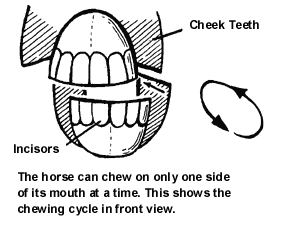
| |
|
|
 |
|
|
HOW HORSES CHEW When a wild horse is hungry, he goes to a place where there is grass to eat and then he puts his nose down and begins biting off the blades. To do this, he uses his upper lip to grasp a group of blades; his tongue to orient the blades as they come into his mouth; and his incisor teeth to nip them off. The horse then uses his tongue to hold the wad of food against the cheek teeth on one side. A horse's chewing motion is normally not up-and-down, but outside-to-inside on a slant determined by the slant of the matching surfaces of the upper and lower cheek teeth. Repeated chews work the mass into a spiraling, cigar-shaped wad. Blades get chopped finer and finer as they work their way down the cheek battery from front to rear, and are then swallowed. Chewing action thoroughly mixes the chopped blades with saliva, which is the first digestive juice. (It's important not to forget that the oral cavity is the first part of the horse's digestive system). After chewing and swallowing a segment of one "cigar," the horse lowers its head to bite off another bunch of blades. The next mouthful may be chewed on either the right or left side, but horses can chew on only one side of the mouth at a time. A normal horse distributes the effort evenly. 
|
|||||||||||||||||||||
Copyright 1994 to 2024 Equiworld at Hayfield, Aberdeen, Scotland - 30 years on the web. Archived Version.